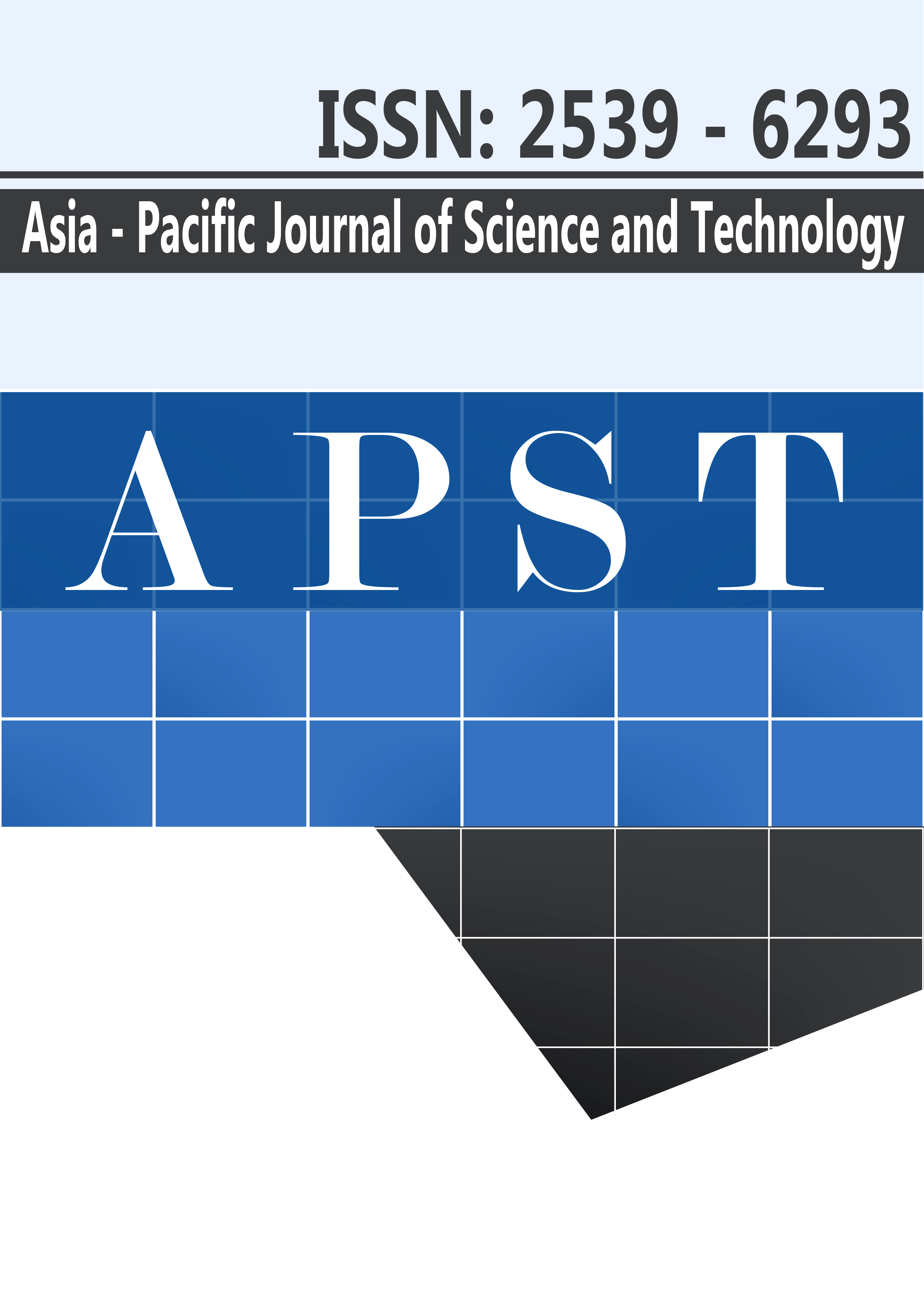Effect of sucrose/glucose syrup ratio and citric acid on physical properties and sensory quality of candy product
Main Article Content
Abstract
The objective of this research was to develop the Thunbergia laurifolia Linn. candy. The experiment was designed as 3×3 Factorial in Completely Randomized Designs to determine the optimal concentration of sucrose (32, 27, 22%) and glucose syrup (27, 22, 17%) in the production of candy. The candy made from sucrose and glucose syrup of 32% : 27% showed the highest overall liking score (7.09) in sensory tests whereas the lowest hardness (116.142 g). Improvement of the T. laurifolia candy taste was investigated by adding citric acid with different concentrations into the product. The addition of 1.4% citric acid had the highest overall acceptability score (7.38). In addition, the T. laurifolia candy had aw of 0.380 and total acidity of 1.381%.
Article Details
References
Thongsaard W. and Marsden C.A. A herbal medicine used in the treatment of addiction mimics the action of amphetamine on in vitro rat striatal dopamine release. Neurosci Lett. 2002 ; 329 :129-132.
Pramyothin P., Chirdchupunsare H., Rungsipipat A., and Chaichantipyuth C. Hepatoprotective activity of Thunbergia laurifolia Linn. extract in rats treated with ethanol: In vitro and in vivo studies. J Ethnopharmacol. 2012 ; 102: 408-411.
Tangpong J. and Satarug S. Alleviation of lead poisoning in the brain with aqueous leaf extract of the Thunbergia laurifolia (Linn.). Toxico Lett. 2010 ; 198 : 83-88.
Oonsivilai R., Cheng C., Bomser J., Ferruzi M.G. and Ningsanond S. Phytochemical profiling and phase II enzyme-inducing properties of Thunbergia laurifolia Lindl. (RC) extracts. J Ethnopharmacol. 2007 ;114: 300-306.
Boonyarikpunchai W., Sukrong S. and Towiwat P. Antinociceptive and anti-inflammatory effects of rosmarinis acid isolated from Thunbergia laurifolia Lindl. Pharmaco Biochem Be. 2014; 124: 67-73.
Wonkchalee O., Boonmars T., Aromdee C., Laummaunwai P., Khunkitti W., Vaeteewoottacharn, P. Sriraj, R. Aukkanimart, W. Loilome, Y. Chamgramol, C. Pairojkul K., Wu Z., Juasook A. and Sudsarn P. Antiinflammatory, antioxidant and hepatoprotective effects of Thunbergia laurifolia Linn. on experimental opisthorchiasis. Parasitol Res. 2012; 111: 353-359.
Khobjai W., jaihan U., Watcharasamphankul W. and Somsak V. Protective effect of Thunbergia laurifolia extract on hemolysis during Plasmodium berghei infection. Parasitol Res. 2014 ;113: 1843-1846.
Aritajat S., Wutteerapol S. and Saenphet K. Anti-diabetic effect of Thunbergia laurifolia Linn. Aqueous extract. Southeast Asian J Trop Med Publ Health. 2004; 35: 53-58.
Suwanchaikasem P., Chaichantipyuth C. and Sukrong S. Antioxidant-guided isolation of rosmarinic acid, a major constituent, from Thunbergia laurifolia and its use as a bioactive principle for standardization. Chiang Mai J Sci. 2014; 41: 117-127.
Jetawattana S., Boonsirichai K., Charoen S. and Martin S. M. Radical intermediate generation and cell cycle arrest by an aqueous extract of Thunbergia laurifolia Linn. In human breast cancer cells. Asian Pac J Cancer P. 2015; 16: 4357-4361.
Chattaviriya P., Morkmek N., Lertprasertsuke N. and Ruangyuttikarn W. Drinking Thunberfia laurifolia Lindl. leaf extract helps prevent renal toxicity induced by cadmium in rats. Thai J Toxico. 2010; 25: 124-132.
Palipoch S., Jiraungkoorsku W., Tansatit T., Preyavichyapugdee N., Jaikua W. and Kosai P. Effect of Thunbergia laurifolia (Linn) leaf extract dietary supplement against lead toxicity in Nile tilapia (Oreochromis niloticus). World J Fish&Marine Sci. 2011a; 3: 1-9.
Palipoch S., Jiraungkoorsku W., Tansatit T., Preyavichyapugdee N., Jaikua W. and Kosai P. Protective efficiency of Thunbergia laurifolia leaf extract against lead (II) nitrate-induced toxicity in Oreochromis niloticus. J Med Plants Res. 2011b; 5: 719-728.
Rocejanasaroj A., Tencomnao T. and Sangkitikomol W. Thunbergia laurifolia extract minimizes the adverse effects of toxicants by regulating P-glycoprotein activity, CYP450, and lipid metabolism gene expression in HepG2 cells. Genet Mol Res. 2014; 13: 205-219.
Thongsaard W. and Marsde C. Effect of Thunbergia laurifolia extract on extracellular dopamine level in rat nucleus accumbens. J Med Assoc Thai. 2013; 96: S85-S89.
Oonsivilai R., Ferruzzi M. G. and Ningsanond S. Antioxidant activity and cytotoxicity of Rang Chuet (Thunbergia laurifolia Lindl.) extracts. As J Food Ag-Ind. 2008; 1(2): 116-128.
Oktavianti S. Study of formulation and product texture on making brown sugar chewy candy. Bachelor’s Thesis. Fakultas Teknologi Pertanian, Institut Pertanian Bogor, Bogor, 2003.
Badan Standarisasi Nasional (BSN). (2008). SNI 3547.1.2008. Bonbon-Section 1: Hardness, Badan Standarisasi Nasional, Jakarta.
Woo A. Use of organic acids in confectionery. The manufactoring confectioner. 1996; 78(8): 63-70.
Garcia T. Analysis and gelatin-based confections. The manufactoring confectioner. 2000; 80(6) : 93-101.
Subaryono S. and Utomo B.S.B. The use of Carrageenan-conjac in jelly candy production. J Pascapanen dan Bioteknologi Kelautan dan Perikanan. 2006; 1(1) : 19-26.
Sinurat E., Murdinah M. and Fransiska D. Characterization of jelly candy made of formulated jelly powder. J Pascapanen dan Bioteknologi Kelautan dan Perikanan. 2010; 5(1) : 57-64.
Beuchat L. R. Microbial stability as affected by water activity.Cereal Food World. 1981; 26(7): 345-349.


